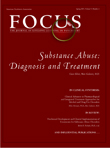Encouraging Posttreatment Self-Help Group Involvement to Reduce Demand for Continuing Care Services: Two-Year Clinical and Utilization Outcomes
Abstract
Background:
Accumulating evidence indicates that addiction and psychiatric treatment programs that actively promote self-help group involvement can reduce their patients' health care costs in the first year after treatment, but such initially impressive effects may wane over time. This paper examines whether the positive clinical outcomes and reduced health care costs evident 1 year after treatment among substance-dependent patients who were strongly encouraged to attend 12-step self-help groups were sustained at 2-year follow-up. Methods: A 2-year quasi-experimental analysis of matched samples of male substance-dependent patients who were treated in either 12-step-based (n = 887 patients) or cognitive-behavioral (CB, n = 887 patients) treatment programs. The 12-step-based programs placed substantially more emphasis on 12-step concepts, had more staff members “in recovery,” had a more spiritually oriented treatment environment, and promoted self-help group involvement much more extensively than did the CB programs. The 2-year follow-up assessed patients' substance use, psychiatric functioning, self-help group affiliation, and mental health care utilization and costs. Results: As had been the case in the 1-year follow-up of this sample, the only difference in clinical outcomes was a substantially higher abstinence rate among patients treated in 12-step (49.5%) versus CB (37.0%) programs. Twelve-step treatment patients had 50 to 100% higher scores on indices of 12-step self-help group involvement than did patients from CB programs. In contrast, patients from CB programs relied significantly more on outpatient and inpatient mental health services, leading to 30% lower costs in the 12-step treatment programs. This was smaller than the difference in cost identified at 1 year, but still significant ($2,440 per patient, p = 0.01). Conclusions: Promoting self-help group involvement appears to improve posttreatment outcomes while reducing the costs of continuing care. Even cost offsets that somewhat diminish over the long term can yield substantial savings. Actively promoting self-help group involvement may therefore be a useful clinical practice for helping addicted patients recover in a time of constrained fiscal resources.
(Reprinted with permission from Alcoholism: Clinical and Experimental Research 2007; 31(1):64–68)



